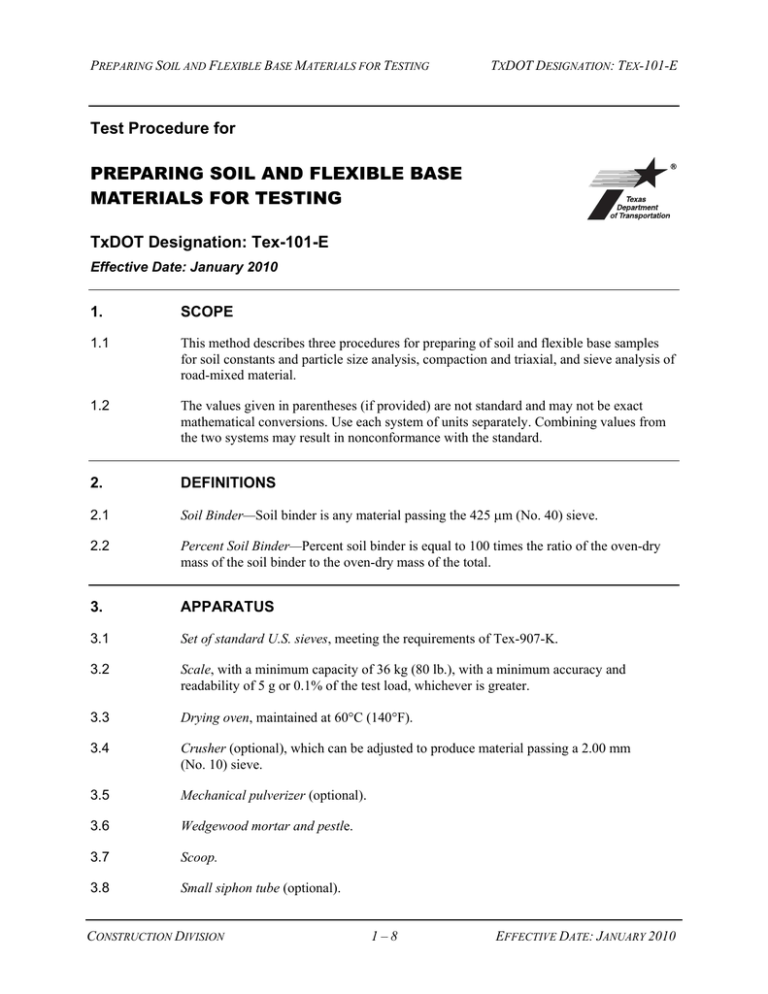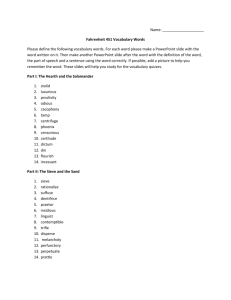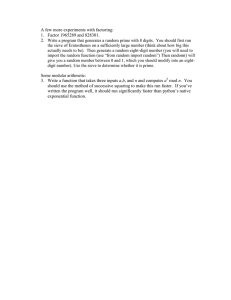Tex-101-E
advertisement

PREPARING SOIL AND FLEXIBLE BASE MATERIALS FOR TESTING TXDOT DESIGNATION: TEX-101-E Test Procedure for PREPARING SOIL AND FLEXIBLE BASE MATERIALS FOR TESTING TxDOT Designation: Tex-101-E Effective Date: January 2010 1. SCOPE 1.1 This method describes three procedures for preparing of soil and flexible base samples for soil constants and particle size analysis, compaction and triaxial, and sieve analysis of road-mixed material. 1.2 The values given in parentheses (if provided) are not standard and may not be exact mathematical conversions. Use each system of units separately. Combining values from the two systems may result in nonconformance with the standard. 2. DEFINITIONS 2.1 Soil Binder—Soil binder is any material passing the 425 m (No. 40) sieve. 2.2 Percent Soil Binder—Percent soil binder is equal to 100 times the ratio of the oven-dry mass of the soil binder to the oven-dry mass of the total. 3. APPARATUS 3.1 Set of standard U.S. sieves, meeting the requirements of Tex-907-K. 3.2 Scale, with a minimum capacity of 36 kg (80 lb.), with a minimum accuracy and readability of 5 g or 0.1% of the test load, whichever is greater. 3.3 Drying oven, maintained at 60C (140F). 3.4 Crusher (optional), which can be adjusted to produce material passing a 2.00 mm (No. 10) sieve. 3.5 Mechanical pulverizer (optional). 3.6 Wedgewood mortar and pestle. 3.7 Scoop. 3.8 Small siphon tube (optional). CONSTRUCTION DIVISION 1–8 EFFECTIVE DATE: JANUARY 2010 PREPARING SOIL AND FLEXIBLE BASE MATERIALS FOR TESTING TXDOT DESIGNATION: TEX-101-E 3.9 Sample containers, metal pans, cardboard cartons. 3.10 Filter paper, non-fibrous. 3.11 Sample splitter, quartering machine, or quartering cloth. 3.12 Mechanical mixer (stirring device). 3.13 Dispenser cup. 3.14 Plaster of Paris molds (optional). Note 1—Dry the plaster of Paris molds at a temperature not to exceed 60C (140F) after forming, and wash and dry after each use. 4. MATERIALS 4.1 Tap water. 5. SAMPLE IDENTIFICATION 5.1 Give each sample an identification number on a suitable card. This card should remain with the sample throughout the processing and testing. PART I—PREPARING SAMPLES FOR SOIL CONSTANTS AND PARTICLE SIZE ANALYSIS 6. SCOPE 6.1 If only soil constants are desired, use either “Dry Preparation (Method A)” or “Wet Preparation (Method B).” However if particle size analysis or percent soil binder is also desired, use Method A. Furthermore, use Method A when preparing a referee test. 7. PREPARING SAMPLES 7.1 Dry Preparation (Method A)—to be used for analysis of soil constants, particle size, or percent soil binder, or when preparing a referee test 7.1.1 Select a representative sample according to the appropriate test method (Tex-100-E or Tex-400-A) large enough to yield at least 300 g of soil binder. 7.1.2 Dry the sample in a 60C (140F) oven. 7.1.3 Examine the sample by visual inspection or slake small portions in water to determine if the material has any particles larger than 425 m (No. 40). CONSTRUCTION DIVISION 2–8 EFFECTIVE DATE: JANUARY 2010 PREPARING SOIL AND FLEXIBLE BASE MATERIALS FOR TESTING TXDOT DESIGNATION: TEX-101-E 7.1.4 If the amount of aggregate larger than 425 m (No. 40) is easily distinguishable, remove these particles by hand and proceed to Section 7.1.27. 7.1.5 For materials containing a considerable amount of aggregate, separate the fine loose binder from the coarse particles by sieving over a 425 m (No. 40) sieve. 7.1.6 Set the soil binder passing the sieve aside to recombine with the additional binder obtained from Sections 7.1.8 through 7.1.24. 7.1.7 If desired, slake the total material. 7.1.8 Place the material to be slaked into a pan. 7.1.9 Cover the material completely with water and soak for a minimum of 12 hours, unless Tex-102-E determines a shorter time. 7.1.10 Place the empty 425 m (No. 40) sieve into a clean pan and pour the liquid from the wet sample through it. 7.1.11 Transfer the wet sample to the sieve in increments not exceeding 450 g. 7.1.12 Pour water over the sieve until the water level is about 12.5 mm (0.5 in.) above the sample on the sieve. 7.1.13 Alternately agitate the sieve up and down and stir the sample by hand. 7.1.14 If the material retained on the sieve contains lumps that have not disintegrated, crumple any that can be broken down between thumb and fingers and wash through the sieve. 7.1.15 After all the soil binder appears to have passed through the sieve, hold the sieve above the pan and wash the retained aggregates clean by pouring a small amount of water over it and letting the water drain into the pan. 7.1.16 Transfer the retained aggregate from the sieve to a clean pan. 7.1.17 Repeat the procedure in Sections 7.1.10 through 7.1.16 until all of the soaked sample has been washed. 7.1.18 Dry the retained aggregate portion of the sample in a 60C (140F) oven. 7.1.19 Re-screen over the 425 m (No. 40) sieve and add the binder passing the sieve to the soil binder obtained in Section 7.1.6. 7.1.20 Weigh the mass of the aggregate and retain for use in Tex-110-E, Part I. 7.1.21 Place the pan containing the soil binder and wash water aside, where it will not be disturbed, until all the soil has settled to the bottom of the pan and the water above the soil is clear. 7.1.22 Decant the water off the soil. CONSTRUCTION DIVISION 3–8 EFFECTIVE DATE: JANUARY 2010 PREPARING SOIL AND FLEXIBLE BASE MATERIALS FOR TESTING TXDOT DESIGNATION: TEX-101-E 7.1.23 Dry the remaining soil in a 60C (140F) oven. 7.1.24 In cases where the materials fail to settle overnight, evaporate the water by placing the sample in a 60C (140F) oven until it is dry, or siphon the water on to a plaster of Paris mold lined with filter paper. 7.1.25 When the water has disappeared, place the filter paper with adhering soil in a pan and dry in the oven. 7.1.26 Sweep the dry soil from the filter paper with a stiff brush into the pan of fines. 7.1.27 Break down the dried soil binder with a mortar and pestle or use a suitable mechanical pulverizer with an opening set from 635 to 889 m (0.025 to 0.035 in.) 7.1.28 If a pulverizer is used, any material still aggregated in lumps larger than 425 m (No. 40) should be broken down with a mortar and pestle. 7.1.29 Combine all of the soil binder obtained and weigh the mass to the nearest 5 g. 7.1.30 Mix thoroughly to produce a uniform sample of all of the particles. 7.1.31 Add the masses obtained in Sections 7.1.20 and 7.1.29, and record the sum as the Total Dry Mass of the sample. 7.2 Wet Preparation (Method B)—to be used for the analysis of soil constants only 7.2.1 Select a representative sample according to Tex-100-E or Tex-400-A. 7.2.2 Make the sample large enough to yield at least 300 g of soil binder. 7.2.3 Place the sample in a clean pan. 7.2.4 Cover the sample completely with clear water. 7.2.5 Soak soils with moderate to high Plasticity Indices (PI) for a minimum of 12 hours, unless Tex-102-E determines a shorter time. 7.2.6 Soak flexible base and low PI materials for a minimum of two hours. 7.2.7 Sieve the wet sample into a clean pan in increments of approximately 450 g over a 2.00 mm (No. 10) sieve to remove large aggregate particles. 7.2.8 Wash the aggregate retained on the sieve with a small amount of water. 7.2.9 Discard the portion of material retained on the sieve. 7.2.10 For soils and base materials with low PI, go to Section 7.2.14. 7.2.11 For soils with moderate to high PI, place the wet material passing the 2.00 mm (No. 10) sieve into the dispersion cup of a mechanical malt mixer. CONSTRUCTION DIVISION 4–8 EFFECTIVE DATE: JANUARY 2010 PREPARING SOIL AND FLEXIBLE BASE MATERIALS FOR TESTING TXDOT DESIGNATION: TEX-101-E 7.2.12 Do not fill the cup more than half-full. 7.2.13 Mix the material for three to five minutes or until the soil binder is separated. 7.2.14 Pour the material through a 425 m (No. 40) sieve into a plaster of Paris bowl lined with filter paper. 7.2.15 Vigorously agitate the sieve up and down over the bowl while occasionally stirring the sample by hand to allow as much material as possible to pass the 425 m (No. 40) sieve. 7.2.16 If the material retained on the sieve contains lumps that have not disintegrated, return to the dispersion cup, and remix and wash through the sieve. 7.2.17 Sieve until at least 95% of the soil binder appears to have passed through the sieve. 7.2.18 Reduce the water content of the material in the plaster of Paris bowl to below the liquid limit. 7.2.19 When the sample can be divided into pie-like wedges, and each wedge can be easily removed, it can be used for testing of soil constants. 7.2.20 If the soil constants are not to be determined immediately, place the material into an airtight container to prevent moisture loss. 8. CALCULATION 8.1 Use the following to calculate the percent soil binder: Percent Soil Binder = 100( W1 WT ) Where: W1 = dry mass of soil binder WT = dry mass of total sample. 9. REPORT 9.1 Report the percent soil binder to the nearest whole percent. PART II—PREPARING SAMPLES FOR COMPACTION AND TRIAXIAL TESTS 10. SCOPE 10.1 Use this part to prepare samples for the compaction and triaxial tests. This procedure applies to all materials, except stabilized material, in the roadway or stockpile condition. CONSTRUCTION DIVISION 5–8 EFFECTIVE DATE: JANUARY 2010 PREPARING SOIL AND FLEXIBLE BASE MATERIALS FOR TESTING TXDOT DESIGNATION: TEX-101-E 11. PREPARING SAMPLES 11.1 Select approximately a 90 kg (200 lb.) representative sample according to Tex-100-E or Tex-400-A. 11.2 Check specifications for maximum aggregate size. 11.3 Spread sample on a clean floor to air dry or use a forced draft of warm air not to exceed 140F (60C) for soils and 230F (110C) for flexible base material. 11.4 Dry soils in accordance with Section 11.4.1 and flexible base in accordance with Section 11.4.2. 11.4.1 Reduce the water content of soil samples to slightly below the estimated optimum moisture content. 11.4.2 Dry flexible base materials to constant weight. Constant weight will be considered achieved when the weight loss is less than 0.1% of the sample weight in four hours of drying. 11.5 Process soils in accordance with Section 11.5.1 and flexible base in accordance with Section 11.5.2. 11.5.1 Process moist clay and other soils (which form hard lumps when dried or contain aggregates) so that it will pass a 6.3 mm (1/4 in.) wire-mesh. 11.5.2 Separate flexible base by dry sieving into the following sizes: 1 3/4 in. (44.5 mm) 1 1/4 in. (31.7 mm) 7/8 in. (22.2 mm) 5/8 in. (16 mm) 3/8 in. (9.5 mm) No. 4 (4.75 mm) No. 40 (0.425 mm). Note 2—Do not overload the screens. The material passing the No. 4 and retained on the No. 40 sieve may need to be shaken separately and in several small batches to avoid overloading the screen. 11.5.3 When material contains aggregate retained on the 44.5 mm (1-3/4 in.) sieve, add the material passing the 1-3/4 in. (44.5 mm) sieve and retained on the 1-1/4 in. (31.7 mm) sieve for recombining individual specimens. Note 3—Do not use particles larger than 1-3/4 in. (44.5 mm) in the compacted specimens. 11.6 When aggregate between 1- 3/4 in. (44.5 mm) and 1-1/4 in. (31.7 mm) is needed, crush particles larger than 1-3/4 in. (44.5 mm) or obtain additional material from the project. CONSTRUCTION DIVISION 6–8 EFFECTIVE DATE: JANUARY 2010 PREPARING SOIL AND FLEXIBLE BASE MATERIALS FOR TESTING TXDOT DESIGNATION: TEX-101-E Note 4—Do not crush the material if it is an uncrushed gravel. 11.7 Mix each size to make moisture as uniform as possible. 11.8 Weigh each size of material to the nearest 0.1 lb (5 g). 11.9 Calculate the cumulative percentages retained on each sieve size as shown under Section 12. 11.10 These values are to be used in recombining the sample for compaction specimens. 12. CALCULATION 12.1 Calculate the cumulative percentages retained on each sieve. Percent Re tained 100( Mass Re tained Total Mass of Sample ) PART III—SIEVE ANALYSIS OF ROAD-MIX STABILIZED MATERIAL 13. SCOPE 13.1 This procedure applies to chemically stabilized materials sampled from the roadway during construction. These materials may be tested in the roadway condition for adequate pulverization, using sieves required by the governing Department Standard Specifications. 14. PROCEDURE 14.1 Select a representative sample from the roadway according to Tex-100-E. 14.2 Reduce the sample, using a sample splitter or other approved method, to a minimum of 4.5 kg (10 lb.) 14.3 Remove all non-slakable aggregates retained on the specified sieves. 14.4 Weigh the sample to the nearest 5 g and record as the Total Mass under Section 15. 14.5 Use the specified sieves to separate the sample into different size fractions. 14.6 Use either a sieve shaker or the hand method in the sieving operation. 14.7 Sieve the sample with a lateral and vertical motion of the sieves, accompanied by a jarring action to keep the material moving over the surface of the sieve. 14.8 Continue the sieving operation until no more than one percent of the test sample, by mass, passes through any sieve after one minute of continuous shaking. CONSTRUCTION DIVISION 7–8 EFFECTIVE DATE: JANUARY 2010 PREPARING SOIL AND FLEXIBLE BASE MATERIALS FOR TESTING TXDOT DESIGNATION: TEX-101-E 14.9 Weigh the material passing each of the required sieves and record its mass to the nearest 5 g. 15. CALCULATION 15.1 Use the following to determine percent material passing each sieve. Percent Passing 100( Mass Passing a Sieve Total Mass of Sample ) 16. REPORT 16.1 Report test results to the nearest whole percent. 17. ARCHIVED VERSIONS 17.1 Archived versions are available. CONSTRUCTION DIVISION 8–8 EFFECTIVE DATE: JANUARY 2010


